|
Have a safe day!
Friday, Oct. 3
3:30 p.m.
DIRECTOR'S COFFEE BREAK - 2nd Flr X-Over
4 p.m.
Joint Experimental-Theoretical Physics Seminar - One West
Speaker: Ornella Palamara, Fermilab
Title: Detection of Short-Range Correlated Nucleon Pairs in Charged-Current Neutrino Interactions at ArgoNeuT
Monday, Oct. 6
2 p.m.
Particle Astrophysics Seminar - Curia II
Speaker: Kevork Abazajian, University of California, Irvine
Title: Implications of the Candidate Dark Matter Decay Line at 3.5 keV
3:30 p.m.
DIRECTOR'S COFFEE BREAK - 2nd Flr X-Over
4 p.m.
All Experimenters' Meeting - Curia II
Visit the labwide calendar to view Fermilab events
|
|
Friday, Oct. 3
- Breakfast: potato pancakes
- Breakfast: chorizo and egg burrito
- Knockwurst and braised cabbage sandwich
- Chana masala
- Jager schnitzel
- German beef sandwich
- Sauteed smoked sausage and spaetzle
- Beef borscht soup
- Texas-style chili
- Assorted pizza by the slice
Wilson Hall Cafe menu
|
|
Friday, Oct. 3
Dinner
Closed
Wednesday, Oct. 8
Lunch
- Chicken schnitzel
- Smashed mustard potatoes
- Apple, fennel and celery slaw
- German chocolate cake
Chez Leon menu
Call x3524 to make your reservation.
|
|
Accelerating the fight against cancer
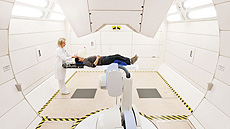 |
| As charged-particle therapies grow in popularity, physicists are working with other experts to make them smaller, cheaper and more effective — and more available to cancer patients in the United States. Photo courtesy of Heidelberg University Hospital |
Once physicists started accelerating particles to high energies in the 1930s, it didn't take them long to think of a killer app for this new technology: zapping tumors.
Standard radiation treatments, which had already been around for decades, send X-rays straight through the tumor and out the other side of the body, damaging healthy tissue both coming and going. But protons and ions — atoms stripped of electrons — slow when they hit the body and come to a stop, depositing most of their destructive energy at their stopping point. If you tune a beam of protons or ions so they stop inside a tumor, you can deliver the maximum dose of radiation while sparing healthy tissue and minimizing side effects. This makes it ideal for treating children, whose developing bodies are particularly sensitive to radiation damage, and for cancers very close to vital tissues such as the optic nerves or spinal cord.
Today, nearly 70 years after American particle physicist Robert Wilson came up with the idea, proton therapy has been gaining traction worldwide and in the United States, where 14 centers are treating patients and nine more are under construction. Ions such as carbon, helium and oxygen are being used to treat patients in Germany, Italy, China and Japan. More than 120,000 patients had been treated with various forms of charged-particle therapy by the end of 2013, according to the Particle Therapy Co-Operative Group.
New initiatives from CERN research center in Europe and the Department of Energy and National Cancer Institute in the United States are aimed at moving the technology along, assessing its strengths and limitations and making it more affordable.
And physicists are still deeply involved. No one knows more about building and operating particle accelerators and detectors. But there's a lot more to know. So they've been joining forces with physicians, engineers, biologists, computer scientists and other experts to make the equipment smaller, lighter, cheaper and more efficient and to improve the way treatments are done.
"As you get closer to the patient, you leave the world accelerator physicists live in and get closer to the land of people who have PhDs in medical physics," says Stephen Peggs, an accelerator physicist at Brookhaven National Laboratory.
"It's alignment, robots and patient ergonomics, which require just the right skill sets, which is why it's fun, of course, and one reason why it's interesting — designing with patients in mind."
Read more
—Glennda Chui
|
The big bang theory
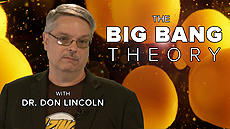 |
The big bang theory says that the universe was once smaller and denser and has been expanding for eons. One common misconception is that it says something about the instant that set the expansion into motion. U.S. CMS Education and Outreach Coordinator Don Lincoln talks about the big bang theory and sketches some ideas about what caused the universe to come into existence. View the video. Video: Fermilab |
|
How many turtles do you see?
 |
| These turtles, catching some rays by the little pond at Site 38, have the right idea. Photo: Sue Quarto, FESS |
|
In memoriam: Dave Carey
Fermilab retiree Dave Carey, age 74, died Wednesday, Oct. 1. Carey retired in 2008 from Fermilab after 39 years of service as a physicist.
Visitation for Carey takes place Sunday, Oct. 5, from 4-7 p.m. at Friedrich-Jones Funeral Home and Cremation Services, 44 S. Mill Street, Naperville, Illinois. Funeral services will follow at 7 p.m.
Memorial donations may be made to Ecumenical Adult Care of Naperville.
Read Carey's obituary.
|
Exploring the monstrous creatures at the edges of the dark matter map
From ars technica, Sept. 30, 2014
Scientists are explorers by nature, and when the edges of their maps are terra incognita, researchers sometimes must give names to phenomena for which we have little knowledge. Sometimes those names linger after we know exactly what an unknown quantity is; X-rays are a classic example. The "X" initially referred to mystery, but by the time physicists determined they were simply a high-energy form of light, the name had stuck.
Dark matter, however, is still a placeholder term. Over the decades since astronomers determined that most of the mass in the cosmos is invisible, researchers have done a much better job of figuring out what dark matter isn't than what it actually is. We know it must be electrically neutral, and it can't be made up of ordinary matter (electrons, atomic nuclei, etc.). And while "dark matter" itself is a general term, physicists have a sort of cartography of hints: areas on the map in which various dark matter candidates reside.
Read more
|
|
Subatomic hydrodynamics
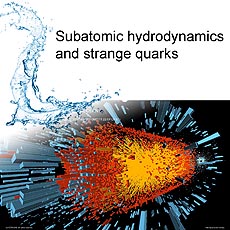 |
| The same basic equations that govern the flow of water are important for describing the collisions of lead nuclei. In today's article, we'll get a glimpse of how this works. |
It's hard for most people to imagine what it's like at the heart of a particle collision. Two particles speed toward one another from opposite directions and their force fields intertwine, causing some of the particles' constituents to be ejected. Or possibly the energy embodied in the interaction might be high enough to actually create matter and antimatter. It's no wonder the whole process seems confusing.
Things get a little easier to imagine when the particles are the nuclei of atoms (note that I said easier, not easy). For collisions between two nuclei of lead, one can imagine two small spheres, each containing 208 protons and neutrons, coming together to collide. Depending on the violence of the collision, some or many of the protons and neutrons might figuratively melt, releasing their constituent quarks so they can scurry around willy-nilly. Physicists call this form of matter a quark-gluon plasma, and it acts much like a liquid.
Part of this liquid-like behavior is due to the fact that so many particles are involved. An LHC collision between two lead nuclei might involve thousands or tens of thousands of particles. Because these particles are quarks and gluons, they experience the strong nuclear force. So as long as they are close enough to each other, the particles interact strongly enough that they clump a bit together. The net outcome is that the flow of particles from collision between lead nuclei looks vaguely like splashes of water. In these cases, the equations of hydrodynamics apply. Mathematical descriptions like these have been used to make sense of other features we see in LHC collisions between lead nuclei.
However, there is more to understand. We can imagine collisions between the collective 416 protons and neutrons of lead nuclei as splashes of water, but when a pair of protons collide, the collision doesn't yield enough particles to exhibit hydrodynamic behavior. So as the number of particles involved goes down, the "splash" behavior must slowly go away. In addition, in the first studies of lead nuclei collisions, only the grossest features of the collision were studied. This is because it is impossible to identify individual quarks and gluons.
There are ways to dig into these sorts of questions. One way is to look at collisions in which one beam is a proton and the other is a lead nucleus. This is a halfway point between the usual LHC proton-proton collisions and the lead-lead ones. In addition, we can turn our attention to quarks that we can unambiguously identify, such as bottom, charm and strange quarks, to better understand the hydrodynamic behavior.
In this study, physicists looked at particles containing strange quarks. Since strange quarks don't exist in the beam protons, studying them gives a unique window into the dynamics of lead-lead collisions. By combining studies of particles with strange quarks in lead-lead and lead-proton collisions, scientists hope to better understand the complicated and liquid-like behavior that is just beginning to reveal its secrets.
—Don Lincoln
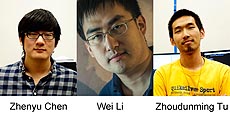 |
| These scientists from Rice University contributed to this analysis. |
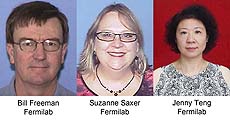 |
| These Fermilab professionals are a crucial part of the support team for the CMS Phase 1 Upgrade. |
|
|